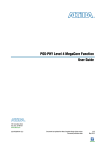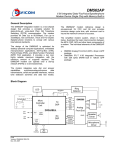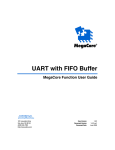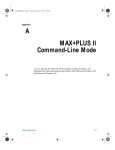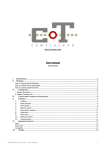Download PPP Packet Processor 622 Mbps Megacore Function (PP622)
Transcript
PPP Packet Processor 622 Mbps MegaCore Function PP622 August 2001 User Guide 101 Innovation Drive San Jose, CA 95134 (408) 544-7000 http://www.altera.com A-UG-IPPP622-1.01 PPP Packet Processor 622 Mbps MegaCore Function (PP622) User Guide Copyright © 2001 Altera Corporation. Altera, The Programmable Solutions Company, the stylized Altera logo, specific device designations, and all other words and logos that are identified as trademarks and/or service marks are, unless noted otherwise, the trademarks and service marks of Altera Corporation in the U.S. and other countries. All other product or service names are the property of their respective holders. Altera products are protected under numerous U.S. and foreign patents and pending applications, maskwork rights, and copyrights. Altera warrants performance of its semiconductor products to current specifications in accordance with Altera’s standard warranty, but reserves the right to make changes to any products and services at any time without notice. Altera assumes no responsibility or liability arising out of the application or use of any information, product, or service described herein except as expressly agreed to in writing by Altera Corporation. Altera customers are advised to obtain the latest version of device specifications before relying on any published information and before placing orders for products or services. All rights reserved. ii Altera Corporation About this User Guide User Guide This user guide provides comprehensive information about the Altera® PPP Packet Processor 622 Mbps MegaCore® Function (PP622). Table 1 shows the user guide revision history. B Go to the following sources for more information: ■ ■ See “Features” on page 10 for a complete list of the core features, including new features in this release. Refer to the PP622 readme file for late-breaking information that is not available in this user guide. Table 1. User Guide Revision History Date How to Find Information December 2000 First version of user guide. August 2001 First revision. Added “Core Verification Summary” section. Revised the “Getting Started” chapter. ■ ■ ■ ■ Altera Corporation Description The Adobe Acrobat Find feature allows you to search the contents of a PDF file. Click on the binoculars icon in the top toolbar to open the Find dialog box, or click the right mouse button for a pull-down menu. Bookmarks serve as an additional table of contents. Thumbnail icons, which provide miniature previews of each page, provide a link to the pages. Numerous links, shown in green text, allow you to jump to related information. iii About this User Guide PPP Packet Processor 622 Mbps MegaCore Function (PP622) User Guide How to Contact Altera For the most up-to-date information about Altera products, go to the Altera world-wide web site at http://www.altera.com. For additional information about Altera products, consult the sources shown in Table 2. Table 2. How to Contact Altera Information Type Access USA & Canada All Other Locations Altera Literature Services Electronic mail [email protected] (1) [email protected] (1) Non-technical customer service Telephone hotline (800) SOS-EPLD (408) 544-7000 (7:30 a.m. to 5:30 p.m. Pacific Time) Fax (408) 544-7606 (408) 544-7606 Telephone hotline (800) 800-EPLD (7:00 a.m. to 5:00 p.m. Pacific Time) (408) 544-7000 (1) (7:30 a.m. to 5:30 p.m. Pacific Time) Fax (408) 544-6401 (408) 544-6401 (1) Electronic mail [email protected] [email protected] FTP site ftp.altera.com ftp.altera.com Telephone (408) 544-7104 (408) 544-7104 (1) World-wide web site http://www.altera.com http://www.altera.com Technical support General product information Note: (1) iv You can also contact your local Altera sales office or sales representative. Altera Corporation PPP Packet Processor 622 Mbps MegaCore Function (PP622) User Guide Typographic Conventions About this User Guide The PPP Packet Processor 622 Mbps MegaCore Function (PP622) User Guide uses the typographic conventions shown in Table 3. Table 3. Conventions Visual Cue Meaning Bold Type with Initial Capital Letters Command names, dialog box titles, checkbox options, and dialog box options are shown in bold, initial capital letters. Example: Save As dialog box. bold type External timing parameters, directory names, project names, disk drive names, filenames, filename extensions, and software utility names are shown in bold type. Examples: fMAX, \maxplus2 directory, d: drive, chiptrip.gdf file. Bold italic type Book titles are shown in bold italic type with initial capital letters. Example: 1999 Device Data Book. Italic Type with Initial Capital Letters Document titles are shown in italic type with initial capital letters. Example: AN 75 (High-Speed Board Design). Italic type Internal timing parameters and variables are shown in italic type. Examples: tPIA, n + 1. Variable names are enclosed in angle brackets (< >) and shown in italic type. Example: <file name>, <project name>.pof file. Initial Capital Letters Keyboard keys and menu names are shown with initial capital letters. Examples: Delete key, the Options menu. “Subheading Title” References to sections within a document and titles of Quartus II and MAX+PLUS II Help topics are shown in quotation marks. Example: “Configuring a FLEX 10K or FLEX 8000 Device with the BitBlaster™ Download Cable.” Courier type Signal and port names are shown in lowercase Courier type. Examples: data1, tdi, input. Active-low signals are denoted by suffix _n, e.g., reset_n. Anything that must be typed exactly as it appears is shown in Courier type. For example: c:\max2work\tutorial\chiptrip.gdf. Also, sections of an actual file, such as a Report File, references to parts of files (e.g., the AHDL keyword SUBDESIGN), as well as logic function names (e.g., TRI) are shown in Courier. 1., 2., 3., and a., b., c.,... Numbered steps are used in a list of items when the sequence of the items is important, such as the steps listed in a procedure. ■ L Bullets are used in a list of items when the sequence of the items is not important. The checkmark indicates a procedure that consists of one step only. H The hand points to information that requires special attention. B The feet direct you to more information on a particular topic. Altera Corporation The angled arrow indicates you should press the Enter key. v About this User Guide Abbreviations and Acronyms vi PPP Packet Processor 622 Mbps MegaCore Function (PP622) User Guide ACCM AHDL CPU CRC (16/32) CRC-CCITT EDA EDIF ESB FCS FIFO HDL HDLC I/O IP LE LSB LSByte Mbps MSB MSByte PC POS-PHY PPP RX RXHLDC SDH SONET SPE STS-3 TX TXHLDC VHDL VHSIC Asynchronous Control Character Map Altera Hardware Description Language Central processing unit Cyclic Redundancy Check 16- or 32-bit Cyclic Redundancy Check Electronic Design Automation Electronic Design Interchange Format Embedded System Block Frame Check Sequence First In First Out Hardware Description Language High-Level Data Link Control Input/Output Intellectual Property Logic Element Least Significant Bit Least Significant Byte Megabits per second Most Significant Bit Most Significant Byte Personal computer Packet Over SONET Physical layer Point-to-Point Protocol Receive Receive High-Level Data Link Control sub-block Synchronous Digital Hierarchy Synchronous Optical Network Synchronous Payload Envelope System Transport Signal level 3 Transmit Transmit High-Level Data Link Control sub-block VHSIC Hardware Description Language Very High Speed Integrated Circuit Altera Corporation Contents User Guide About this User Guide How to Find Information .............................................................................................................. iii How to Contact Altera .................................................................................................................. iv Typographic Conventions ..............................................................................................................v Abbreviations and Acronyms ...................................................................................................... vi Specifications General Description .........................................................................................................................9 Features ...........................................................................................................................................10 Receive Features .....................................................................................................................10 Transmit Features ..................................................................................................................10 Functional Description ..................................................................................................................11 Receiver Description ......................................................................................................................11 RXHDLC .................................................................................................................................11 Byte Alignment ..............................................................................................................12 Descrambling ..................................................................................................................13 Processing .......................................................................................................................13 FCS 16/32 ........................................................................................................................13 FCS Deletion ...................................................................................................................13 Transmitter Description ................................................................................................................13 TXHDLC ..................................................................................................................................13 Processing .......................................................................................................................14 FCS 16/32 ........................................................................................................................14 Scrambling ......................................................................................................................14 Interfaces & Protocols ....................................................................................................................14 Midbus Interface ....................................................................................................................14 AIRbus Interface ....................................................................................................................14 Atlantic Interface ....................................................................................................................15 Data Ordering .................................................................................................................15 Transparency ..................................................................................................................15 I/O Signals ......................................................................................................................................16 Performance ....................................................................................................................................17 Software Interface ..........................................................................................................................18 Memory Map ..........................................................................................................................18 Registers ..................................................................................................................................18 RX Register Description ................................................................................................19 RX_CTRL - Receive Control Register - 'h00 ........................................................19 RX_IS - Receive Interrupt Register - 'h02 ........................................................... 20 RX_IE - Receive Interrupt Enable Register - 'h04 .............................................. 21 Altera Corporation vii Contents PPP Packet Processor 622 Mbps MegaCore Function (PP622) User Guide RX_PM_GOOD - Receive Good Packet Count - 'h06 ....................................... 21 RX_PM_FCS - Receive FCS Error Count - 'h08.................................................. 21 RX_PM_ABORT - Receive Abort Count - 'h0A ................................................. 21 RX_PM_RUNT - Receive Runt Frame Count - 'h0C ......................................... 22 TX Register Description ................................................................................................22 TX_CTRL - Transmit Control Register - 'h10 ..................................................... 22 TX_IS - Transmit Interrupt Register - 'h12 ......................................................... 23 TX_IE - Transmit Interrupt Enable Register - 'h14 ............................................ 23 TX_PM_GOOD - Transmit Good Packet Count - 'h16 ..................................... 23 TX_PM_ERR - Transmit Error Packet Count - 'h18 .......................................... 24 Core Verification Summary ..........................................................................................................24 Simulation Environment .......................................................................................................24 Compatibility Testing Environment ...................................................................................25 Getting Started Design Walkthrough .....................................................................................................................27 Obtaining & Installing the PP622 ................................................................................................28 Downloading the MegaCore Function ...............................................................................28 Installing the MegaCore Files ...............................................................................................28 Generating a PP622 ........................................................................................................................29 Implementing the System .............................................................................................................30 Simulating Your Design ................................................................................................................30 Using the Verilog Demo Testbench .....................................................................................30 Using the Visual IP Software ...............................................................................................31 Synthesis, Compilation & Place & Route ...................................................................................31 Using Third-Party EDA Tools for Synthesis ......................................................................31 Using the Quartus II development tool for compilation and place-and-route .............31 Licensing for Configuration .........................................................................................................32 Performing Post-Routing Simulation ..........................................................................................32 viii Altera Corporation Specifications User Guide General Description The following functions are not supported by the PP622: ■ ■ ■ ■ ■ RFC1662 ACCM Bit stuffing Non-flag inter-frame fill Transparent mode (FCS not appended to transmit frame) Maximum length frame check For the purpose of this user guide, "receive" indicates data flowing into the PP622 from the Midbus interface for transmission through the AtlanticTM interface; "transmit" indicates data received from the Atlantic interface for transmission through the Midbus interface. Thus the Atlantic interface is the source for transmit packets, and the sink for received packets. The PPP Packet Processor 622 Mbps MegaCore® Function (PP622) uses the MegaWizard® Plug-In—within the Quartus® II software—to generate variants in VHDL, AHDL, or Verilog HDL, which you can instantiate into your design. Table 1 shows the optional features available to generate the PP622. Only the basic configuration of PP622 is available. Table 1. Optional Features Options Basic Configuration Note (1) Parameters Choices – – LEs ESBs 1,197 0 Note: (1) Altera Corporation The numbers for the LEs and ESBs are approximate as of August 2001. Users are strongly advised to run the MegaWizard Plug-In and the Quartus II software to see exact numbers for the PP622. 9 1 Specifications The PP622 encapsulates user data packets using HDLC-type framing, in compliance with the Internet Request For Comment—RFC 1622 and RFC 2615—documents. For a link to these documents, please visit the Internet Engineering Task Force web site at: http://www.ietf.org/rfc. Specifications Features PPP Packet Processor 622 Mbps MegaCore Function (PP622) User Guide Receive Features ■ ■ ■ ■ ■ ■ ■ ■ ■ ■ ■ ■ Extraction of octet-synchronous PPP packets from a single STS-12 SPE Arbitrary packet length (one or more octets) Packet delineation and destuffing of all stuffed octets Byte-realignment (software programmable) Descrambling (software programmable) Error detection by CRC-32 and CRC-CCITT FCS Flag sequence deletion FCS deletion (software programmable) RFC1662 and RFC 2615 compliant HDLC-type framing (some sections are not implemented) Performance monitoring by counting: – Good frames – Bad FCS – Aborted frames – Runt frames Error detection: – FCS – Runt Optional removal of FCS Transmit Features ■ ■ ■ ■ ■ ■ ■ ■ ■ ■ 10 RFC1662 and RFC 2615 compliant HDLC-type framing (some sections are not implemented) Flag octets and control-escape octets stuffing in message and FCS for transparency 16- or 32-bit FCS appended to packet Flag sequence insertion between packets for under utilized paths Flag sharing (single flag between frames) Scrambling (software programmable) Automatic abortion in case of transmit underflow, or by host command from Atlantic interface Arbitrary packet length (one or more octets) Automatic appending of FCS to transmitted frames Performance monitoring by counting: – Good frames – Underflows – Aborted packets Altera Corporation GettiSpecifications PPP Packet Processor 622 Mbps MegaCore Function (PP622) User Guide The PP622 is a fully static, reusable, easy to replicate, single-channel processor (no interleaving) which operates in octet-synchronous mode, and offers full-duplex processing capability. Figure 1 shows a complete block diagram of the PP622, including the three interfaces that support it. See “Interfaces & Protocols” on page 14 for more information. Figure 1. Block Diagram PP622 rxclk rxreset_n Midbus Interface arxena RXHDLC arxdav arxdiv mrxdat[7:0] mrxena arxdat[7:0] arxsop arxeop arxerr txclk txreset_n atxena Atlantic Interface atxdiv atxdav TXHDLC atxval Midbus Interface atxdat[7:0] mtxdat[7:0] atxeop mtxena atxsop irq dtack rdata[15:0] wdata[15:0] addr[4:1] read sel atxerr AIRbus Interface Receiver Description The PP622 receives data from the Midbus interface and forwards it to the RXHLDC block for processing. RXHDLC The RXHDLC block processes the data in the incoming PPP packet. The following descriptions explain the principle functions of the RXHLDC block. Altera Corporation 11 1 Specifications Functional Description Specifications PPP Packet Processor 622 Mbps MegaCore Function (PP622) User Guide Byte Alignment Byte alignment aligns the boundaries of the PPP bytes (flags, CRC, etc.) with the boundaries of the packet processor. This function is necessary if the transmission facility does not preserve byte boundaries. If the byte boundaries are preserved (as in SONET), this function should be disabled. Assume the following packet: Clock Cycle Contents Bit 7 Bit 6 Bit 5 Bit 4 Bit 3 Bit 2 Bit 1 Bit 0 1 flag 0 1 1 1 1 1 1 0 2 flag 0 1 1 1 1 1 1 0 3 data a b c d e f g h 4 data i j k l m n o p 5 FCS c c c c c c c c 6 FCS c c c c c c c c 7 flag 0 1 1 1 1 1 1 0 8 flag 0 1 1 1 1 1 1 0 If the data becomes misaligned by 2 bits, the bytes on the Midbus are as follows: Clock Cycle Bit 7 Bit 6 Bit 5 Bit 4 Bit 3 Bit 2 Bit 1 Bit 0 1 x x 0 1 1 1 1 1 2 1 0 0 1 1 1 1 1 3 1 0 a b c d e f 4 g h i j k l m n 5 o p c c c c c c 6 c c c c c c c c 7 c c 0 1 1 1 1 1 8 1 0 0 1 1 1 1 1 9 1 0 x x x x x x Symptoms of misalignment are: ■ ■ 12 Extremely long packets: They typically occur during line idle, when the bus is normally carrying flags. The flags no longer look like flags, but like packet data. In the above example, the flags are converted into 10011111. Excessive error rate: Random data patterns may, when shifted, masquerade as flags and hence mark the start and stop of packets. This is likely to cause FCS errors and, less likely, runts or aborts. Altera Corporation PPP Packet Processor 622 Mbps MegaCore Function (PP622) User Guide GettiSpecifications If it detects a misalignment, the aligner rearranges the data to compensate. This function is enabled via the Receive Control Register. The receive frame and between-frame flags are descrambled using a selfsynchronizing descrambler. The generator polynomial used is the standard x43+1. Descrambling can be enabled or disabled via the Receive Control Register. The inter-frame fill is then discarded, and the frame is forwarded for processing. Processing Processing involves taking the descrambled frame, detecting the start of frame and end of frame indicated by flags, and removing the stuff octets (control escape characters). Aborted frames are also detected. FCS 16/32 The FCS 16/32 blocks check for errors by calculating a syndrome, and by using either the CRC-16 (x16+ x12+ x5 +1) or CRC-32 (x32+ x26+ x23 + x22+ x16+ x12+ x11+ x10+ x8+ x7+ x5+ x4+ x2+ x +1) generator polynomial as an FCS. All packets—good packets, packets with CRC errors, aborted packets, and runt packets—are counted in statistics registers. FCS Deletion FCS Deletion removes the FCS from the frame. Removal of the FCS is enabled or disabled via the Receive Control Register. The frame is then passed to the Atlantic interface. Transmitter Description The PP622 takes in packets from the Atlantic interface and passes them to the TXHDLC block for processing. TXHDLC The TXHDLC block frames the data in the incoming transmit stream. The following descriptions explain the principle functions of the TXHLDC block. Altera Corporation 13 Specifications Descrambling 1 Specifications PPP Packet Processor 622 Mbps MegaCore Function (PP622) User Guide Processing The TXHDLC block inserts the FCS into the data stream for stuffing at the end of a normal packet. The TXHDLC also inserts the abort sequence as needed into the data stream for aborted packets, and inserts flags between frames. It also stuffs the data and FCS octets for transparency. Stuffing is performed 8 bits at a time (byte oriented) for high performance, and low gate count. When enabled, it delivers octets to the Midbus interface. FCS 16/32 The FCS is calculated using the CRC-16 or CRC-32 generating polynomial. Scrambling The transmit data stream is scrambled using the x43+1 polynomial. Scrambling can be enabled or disabled via the Transmit Control Register. The packet is sent to the Midbus interface for transmission. Interfaces & Protocols Midbus Interface The Midbus interface is a simple synchronous full-duplex data path bus. The PP622 Midbus runs at 77.76 MHz over a single byte lane in each direction. In the receive direction (RX), data is transferred from the Midbus master to the slave (PP622). In the transmit direction (TX), data is transferred from the slave (PP622) to the master. In each direction, the Midbus can carry 8 bits per clock cycle. It includes Midbus receive data (mrxdat[7:0]) and Midbus receive enable (mrxena) lines to indicate valid data transfers in the RX direction, and Midbus transmit data (mtxdat[7:0]) and Midbus transmit enable (mtxena) lines to indicate valid data requests in the TX direction. Since the PP622 is a slave to the Midbus it can work with any Midbus master. AIRbus Interface The AIRbus interface provides access to internal registers using a simple synchronous internal bus protocol. This consists of separate read data (rdata[15:0]) and write data (wdata[15:0]) buses, a data transfer acknowledge (dtack) signal, and a select (sel) signal. An address (addr[4:1]) bus and read (read) signal indicate the location and type of access within the block. The rdata buses and dtack signals can be merged from multiple blocks using a simple OR function. The dtack signal is sustained until the block sel is removed (four-way handshaking) meaning the AIRbus can cross clock domain boundaries. The PP622 is an AIRbus slave with a data width of 16 bits. 14 Altera Corporation PPP Packet Processor 622 Mbps MegaCore Function (PP622) User Guide GettiSpecifications Atlantic Interface 1 B The arxdav, atxdiv, and atxsop signals are provided, but are not used. More detailed information on the Midbus, AIRbus, and Atlantic is available from the Altera web site at http://www.altera.com. Data Ordering Data is transferred in parallel (8 bits at a time) in the same order it was received internally between the PP622 and the interfaces, but it is ultimately transmitted/received MSB first through external bit-serial mediums such as SONET and SDH (optical fibre), in keeping with telephony convention. This convention of MSB first is not followed in doing CRC (FCS/syndrome) calculations, which use data communications LSB first conventions. In CRC calculations, the LSB of each octet is nominally processed first. CRC calculations are actually done in parallel though the calculation simulates a bit-serial LSB first calculation. The order that octets go into the CRC calculation is the same as the transmission order. The difference in ordering has no practical effect as long as both ends follow the same convention. It is important to specify the nominal order within the bits on the Atlantic and Midbus interfaces. Transparency Special flag characters delimit the start and end of a PPP frame. These special characters are known as a Flag Sequence, which is the binary sequence 01111110 (hexadecimal 0x7e). There is no length field, loss of carrier, or other delimiter of packet boundaries. Since the data in the packet is unrestricted, all data patterns are valid. Transparency is achieved when the framing protocol stuffs flag and escape characters as explained in RFC1662: “An octet stuffing procedure is used. The Control Escape octet is defined as binary 01111101 (hexadecimal 0x7d), most significant bit first (...) Altera Corporation 15 Specifications The Atlantic interface is a full-duplex synchronous bus protocol supporting both packets and cells. The PP622 is an Atlantic interface master using an 8-bit wide data path, clocked at 77.76 MHz, to deliver packets to the slave. Specifications PPP Packet Processor 622 Mbps MegaCore Function (PP622) User Guide After FCS computation, the transmitter examines the entire frame between the two Flag Sequences. Each Flag Sequence, Control Escape octet (...) is replaced by a two octet sequence consisting of the Control Escape octet followed by the original octet exclusive-or'd with hexadecimal 0x20 (...) 0x7e is encoded as 0x7d, 0x5e. (Flag Sequence) 0x7d is encoded as 0x7d, 0x5d. (Control Escape) (...)” RFC1662 also defines an ACCM for the convenience of software and hardware designed for transferring text files. This allows other special characters to be stuffed as directed by the user. The PP155 does not implement the ACCM, thus the TXHDLC does not stuff anything other than the flag and control escape patterns. However, in accordance with RFC1662, the RXHDLC destuffs any stuffed octets. “On reception (...) Each Control Escape octet is also removed, and the following octet is exclusive-or'd with hexadecimal 0x20, unless it is the Flag Sequence (which aborts a frame). Table 2 describes the input/output signals used by the PP622. I/O Signals Table 2. I/O Signals (Part 1 of 2) Port Direction Description Receive Interface Signals rxclk Input Clock rxreset_n Input Active low reset Midbus Receive Interface Signals mrxena Input Enable mrxdat[7:0] Input Data bus Atlantic Receive Interface Signals arxena Output Enable arxdav Input Data available arxdiv Output Data divider arxdat[7:0] Output Data bus arxsop Output Start of packet arxeop Output End of packet arxerr Output Error indication 16 Altera Corporation PPP Packet Processor 622 Mbps MegaCore Function (PP622) User Guide GettiSpecifications 1 Table 2. I/O Signals (Part 2 of 2) Direction Specifications Port Description Transmit Interface Signals txclk Input Clock txreset_n Input Active low reset Midbus Transmit Interface Signals mtxena Input Enable mtxdat[7:0] Output Data bus Atlantic Transmit Interface Signals atxena Output Enable atxdav Input Data available atxdiv Input Data divider atxval Input Enable atxdat[7:0] Input Data bus atxsop Input Start of packet atxeop Input End of packet atxerr Input Error indication AIRbus Interface Signals sel Input Select read Input Read: High for read cycles, Low for writes addr[4:1] Input Address wdata[15:0] Input Write data rdata[15:0] Output Read data: All zeros if sel is not asserted. dtack Output Data transfer acknowledge irq Output Interrupt request Performance Table 3 shows the required speed and estimated gate count of PP622 in an APEX 20KE device. Table 3. Performance Note (1) LEs ESBs fMAX (MHz) 1,197 0 77.76 required to support 622.08 Mbps Note: (1) Altera Corporation The numbers for the LEs and ESBs are approximate as of August 2001. 17 Specifications Software Interface PPP Packet Processor 622 Mbps MegaCore Function (PP622) User Guide Memory Map All addresses access 16-bit registers and are shown as hexadecimal values. The value is the byte address, thus bit 0 is not used. All addresses are even. Address Register Description 'h00 RX_CTRL Receive Control Register 'h02 RX_IS Receive Interrupt Register 'h04 RX_IE Receive Interrupt Enable Register 'h06 RX_PM_GOOD Receive Good Packet Count 'h08 RX_PM_FCS Receive FCS Error Count 'h0A RX_PM_ABORT Receive Abort Count 'h0C RX_PM_RUNT Receive Runt Frame Count 'h10 TX_CTRL Transmit Control Register 'h12 TX_IS Transmit Interrupt Register 'h14 TX_IE Transmit Interrupt Enable Register 'h16 TX_PM_GOOD Transmit Good Packet Count 'h18 TX_PM_ERR Transmit Error Packet Count Registers The following is a list of access codes used to describe the type of register bits. Code 18 Description RW Read/Write RO Read-Only RW1C Read/Write 1 to Clear RW0S Read/Write 0 to Set RTC Read to Clear RTS Read to Set RTCW Read to Clear/Write RTSW Read to Set/Write RWTC Read/Write any value to Clear RWTS Read/Write any value to Set RWSC Read/Write Self-Clearing RWSS Read/Write Self-Setting UR0 Unused bits/Read as 0 UR1 Unused bits/Read as 1 Altera Corporation PPP Packet Processor 622 Mbps MegaCore Function (PP622) User Guide GettiSpecifications RX Register Description 1 RX_CTRL - Receive Control Register - 'h00 (Part 1 of 2) Field REALIGN Bits 5 Access RWSC Function 1: Forces aligner to try new alignment Default 0 Writing a 1 to this bit (note that it always reads as 0) forces the byte aligner to try a new alignment. This bit is ignored if align is 0. ALIGN 4 RW 0: Byte alignment disabled. 1: Byte alignment enabled. 0 If set, the aligner monitors the error rate to determine if the PPP bytes are aligned to mrxdat. If data are not aligned, it shifts the data on mrxdat to attempt to align the data. If cleared, the PPP bytes are assumed to be aligned to mrxdat. CRCLEN 3 RW 0: CRC-CCITT mode 1: CRC-32 mode 0 If set, the receiver computes syndromes for received packets using the CRC-32 polynomial, if cleared, the CRCCCITT 16-bit polynomial. The syndrome is always computed and checked. Packets with bad syndromes (i.e. with errors) are not discarded, but are counted in the Receive FCS Error Count register and marked as erroneous when sent to the Atlantic interface. SCRAMEN 2 RW Enable descrambling of transmit frame and descrambling of 0 the receive frame. This causes the received data stream to be descrambled using the x^43+1 scrambling polynomial. The bits are descrambled using the most significant (higher-numbered) bit first. All bits, including flags, the body of the packet, and the FCS are scrambled. The descrambling process is selfsynchronizing. The descrambler is not reset by the enable bit and will therefore synchronize the state with the received data stream while the enable is cleared. It should, therefore, be set to its desired value and at least 43 bits of data should be received before turning on the enable bit. Altera Corporation 19 Specifications The following tables describe the registers for the receiver section of the PP622. Specifications PPP Packet Processor 622 Mbps MegaCore Function (PP622) User Guide RX_CTRL - Receive Control Register - 'h00 (Part 2 of 2) Field DELFCS Bits 1 Access RW Function Default 0: Store FCS with received packet. 1: Delete FCS from received frame. 0 If cleared, the packet is delivered to the Atlantic interface with the FCS appended. Setting this bit causes the receiver to remove the FCS before sending the packet to the Atlantic interface. Users may set this bit to improve the performance of the Atlantic interface or to simplify downstream processing of the packet. This function requires that the crclen bit be set properly. ENABLE 0 RW 0: Disable packet reception. 1: Enable packet reception. 0 Clearing this bit to zero places the internal state variables in the idle condition, clears the status register, and all receive performance monitor counts (good, FCS, runt, abort). Setting it enables all functions. RX_IS - Receive Interrupt Register - 'h02 Field GOOD Bits 4 Access RW1C Function Default Set if a good packet is received. 0 This is set if a legal, correct packet is received. UNALIGNED 3 RW1C Set if receiver is unaligned. 0 This is set when the receive aligner is not in the aligned state. To determine when the aligner has regained alignment, software should read and clear this bit periodically until it stays cleared. Clearing align in the control register prevents this bit from being set, but does not clear the bit. FCS 2 RW1C ABORT 1 RW1C Set if an FCS error occurs. 0 This is set if a packet with an incorrect FCS is received. Set if a receive packet is aborted. 0 This is set if a packet terminated with an abort sequence is received. RUNT 20 0 RW1C Set if a runt packet is received. This is set if an illegally short packet is received. 0 Altera Corporation PPP Packet Processor 622 Mbps MegaCore Function (PP622) User Guide GettiSpecifications 1 RX_IE - Receive Interrupt Enable Register - 'h04 Bits Access Function Default GOOD 4 RW Enables the receive good interrupt status. 0 UNALIGNED 3 RW Enables the receive unaligned interrupt status. 0 FCS 2 RW Enables the receive FCS interrupt status. 0 ABORT 1 RW Enables the receive abort interrupt status. 0 RUNT 0 RW Enables the receive runt interrupt status. 0 RX_PM_GOOD - Receive Good Packet Count - 'h06 Field CNT Bits 15:0 Access RTCW Function Count of correctly received packets. Default 0 Each correctly received packet (good FCS, not aborted, not a runt) causes this count to increment by one. The counter saturates at 0xFFFF: it will not wrap to 0. Reading this register clears the count. 16-bit values may be written to this register for testing. RX_PM_FCS - Receive FCS Error Count - 'h08 Field CNT Bits 15:0 Access RTCW Function Count of received packets with bad FCS. Default 0 Packets that are not runts and are not aborted but which have bad CRC syndromes increment this count. The counter saturates at 0xFFFF and does not wrap to 0. Reading this register clears the count. RX_PM_ABORT - Receive Abort Count - 'h0A Field CNT Altera Corporation Bits 15:0 Access RTCW Function Count of received packets terminated with ABORT. Default 0 21 Specifications Field Specifications PPP Packet Processor 622 Mbps MegaCore Function (PP622) User Guide RX_PM_RUNT - Receive Runt Frame Count - 'h0C Field CNT Bits 15:0 Access RTCW Function Default Count of runt frames. 0 Runt packets are packets received with frames shorter than 3 or 5 octets (depending on the setting of crclen), not including stuff octets and flags. Individual runt packets increment the count. The counter saturates at 0xFFFF and does not wrap to 0. Reading this register clears the count. 32-bit values may be written to this register for testing. TX Register Description The following tables describe the registers for the transmitter section of the PP622. TX_CTRL - Transmit Control Register - 'h10 Field CRCLEN Bits 2 Access RW Function Default Set to 1 for CRC-32 (32 bits); 0 for CRC-CCITT (16 bits). 0 If set, the transmit section computes FCSs for transmit packets using the CRC-32 polynomial; if cleared, the CRCCCITT 16-bit polynomial is used. The FCS is always generated and appended. SCRAMEN 1 RW Enables scrambling of the transmit frame. 0 This causes the transmitted data stream to be scrambled using the x^43+1 scrambling polynomial. The bits are scrambled using the most significant (higher-numbered) bit first. All bits, including flags, the body of the packet, and the FCS are scrambled. ENABLE 0 RW 0: Disable packet transmission. 1: Enable packet transmission. 0 Clearing this bit to zero places the internal state variables in the idle condition, clears the status registers and all transmit performance monitor counts (good, error). Setting it enables all functions. 22 Altera Corporation PPP Packet Processor 622 Mbps MegaCore Function (PP622) User Guide GettiSpecifications 1 TX_IS - Transmit Interrupt Register - 'h12 GOOD Bits 2 Access RW1C Function Set if a packet is transmitted correctly. Default 0 This bit is set by the transmission of a complete packet with no errors. ERR 1 RW1C Set if a packet is aborted (atxerr asserted simultaneously with atxeop). 0 This is set if atxerr is asserted. Software writes a 1 to this bit to clear it. UNDERFLOW 0 RW1C Set if the FIFO has underflowed. 0 This bit is set if the Atlantic interface does not supply data when required (i.e atxval = 0 in the middle of a packet). If atxval is negated after sending a complete packet and before starting a new packet no underflow is reported. An underflow aborts the current packet and discards the remainder. Subsequent packets are transmitted normally. Software writes a 1 to this bit to clear it. TX_IE - Transmit Interrupt Enable Register - 'h14 Field Bits Access Function Default GOOD 2 RW Enables the transmit good interrupt status. 0 ERR 1 RW Enables the transmit err interrupt status. 0 UNDERFLOW 0 RW Enables the transmit underflow interrupt status. 0 TX_PM_GOOD - Transmit Good Packet Count - 'h16 Field CNT Bits 15:0 Access RTCW Function Count of correctly transmitted packets. Default 0 Each correctly transmitted packet (no underflow, not aborted) causes this count to increment by one. The counter saturates at 0xFFFF; it does not wrap to 0. Reading this register clears the count. 16-bit values may be written to this register for testing. Altera Corporation 23 Specifications Field Specifications PPP Packet Processor 622 Mbps MegaCore Function (PP622) User Guide TX_PM_ERR - Transmit Error Packet Count - 'h18 Field CNT Bits 15:0 Access RTCW Function Default Count of transmitted packets terminated with ABORT. 0 Packets which are not runts but which are terminated by an abort sequence increment this count. The counter saturates at 0xFFFF; it does not wrap to 0. Reading this register clears the count. Core Verification Summary The PP622 was the object of very thorough verification for operation according to industry standards. The PP622 was tested by simulation, and in-circuit for third-party compatibility. Both test environments are described briefly, including the number of test programs, and their results. Simulation Environment The PP622 was simulated using behavioral utilities with multiple simulators, including but not limited to ModelSim SE. The behavioral utilities consist of generic flow control generators and monitors, Midbus generators and monitors, Atlantic generators and monitors, an AIRbus master model, and clock generators. A test suite using the utilities and the RTL model of the PP622 was used to verify the proper operation of all the features listed on page 10. Table 4 lists the results of the simulation for the PP622 Table 4. Results Number of test programs (1) 64 Number of test programs passing 64 Number of test programs failing 0 Number of test cases (1) 118 Number of test cases passing 118 Number of test cases failing 0 Note: (1) 24 Each test program contains at least one test case. Altera Corporation PPP Packet Processor 622 Mbps MegaCore Function (PP622) User Guide GettiSpecifications Compatibility Testing Environment 1 Software from a host PC was used to set registers on the PP622, and the third-party packet processor. The effects of setting these registers, and any corresponding registers, were observed to determine functionality. Tests were run for extended periods of time, thereby testing millions of packets. Figure 2. Test Board Third-Party ASSP APEX EP20K1000EFC672 Table 5 lists the results of the hardware verification for the PP622. Table 5. Results Number of test programs (1) 24 Number of test programs passing 24 Number of test programs failing 0 Number of test cases (1) 27 Number of test cases passing 27 Number of test cases failing 0 Note: (1) Altera Corporation Each test program contains at least one test case. 25 Specifications The PP622 was evaluated—within an APEX EP20K1000EFC672 device— against a commercial third-party packet processor with similar features, as required by industry standards. For testing purposes, the PP622 was interconnected with the Altera STS12CFRM MegaCore function, and the Altera PCI MegaCore function was used to interface to the AIRbus and to the third-party packet processor. Figure 2 shows the test board used. Notes: Getting Started User Guide This section describes how to obtain a variant from the PPP Packet Processor 622 Mbps MegaCore® Function (PP622). It explains how to install the PP622 on your PC, and walks you through the process of implementing the variant in a design. 2 Design Walkthrough This design walkthrough involves the following steps: 1. Obtaining and installing the PP622 MegaCore Function. 2. Generating a PP622 for your system using the MegaWizard® Plug-In. 3. Implementing the rest of your system using AHDL, VHDL, or Verilog HDL. 4. Simulating the PP622 within your design. 5. Synthesis, compilation, and place-and-route. 6. Licensing the PP622 to configure the device. 7. Performing post-routing simulation. The instructions assume that: ■ ■ ■ ■ Altera Corporation You are using a PC You are familiar with the Quartus II software. The Quartus II software (the newest version) is installed in the default location. You are using the OpenCore feature to test-drive a PP622, or you have licensed it. 27 Getting GettingStarted Started You can test-drive a PP622 using the Altera® OpenCore® feature—within the Quartus® II software—to instantiate it, to perform place-and-route, to perform static timing analysis, and to simulate it using a third-party simulator, within your custom logic. You only need licenses when you are ready to generate programming files. Getting Started Obtaining & Installing the PP622 PPP Packet Processor 622 Mbps MegaCore Function (PP622) User Guide To start using the PP622, you need to obtain the MegaCore package, which includes the following: ■ ■ ■ ■ ■ ■ Data sheet User guide AIRbus, Midbus, and Atlantic interface functional specifications MegaWizard Plug-In – Encrypted gate level netlist – Place-and-route constraints (where necessary) – Secure RTL simulation model Demo testbench Access to problem reporting system Downloading the MegaCore Function If you have Internet access, you can download the PPP Packet Processor 622 Mbps MegaCore function from the Altera web site. Follow the instructions below to obtain the core via the Internet. If you do not have Internet access, you can obtain the core from your local Altera representative. 1. Point your web browser at http://www.altera.com/IPmegastore. 2. In the IP MegaSearch keyword field type PPP. 3. Click the link for the PPP Packet Processor 622 Mbps MegaCore function. 4. On the product page, click the Free Test-Drive icon. 5. Follow the on-line instructions to download the function and save it to your hard disk. Installing the MegaCore Files Use the MegaWizard Plug-In to generate the files and install them on your PC. The following instructions describe this process. For UNIX systems, you must have Java runtime environment version 1.3 before you can use the MegaWizard Plug-In. You can download this file from the Java web site at http://www.java.sun.com. For Windows, follow the instructions below: 1. 28 Click Run (Start menu). Altera Corporation PPP Packet Processor 622 Mbps MegaCore Function (PP622) User Guide 2. Type <path name>\<filename>.exe, where <path name> is the location of the downloaded PP622 and <filename> is the filename of the PP622. Click OK. 3. The MegaCore Installer dialog box appears. Follow the MegaWizard Plug-In instructions to finish the installation. 4. Disregard this step if you are using Quartus II version 1.1 or higher. Otherwise, after you have finished installing the files, you must specify the directory in which you installed them as a user library in the Quartus II software. Search for “User Libraries” in Quartus II Help for instructions on how to add these libraries. This section describes the design flow using the PPP Packet Processor 622 Mbps MegaCore function and the Quartus II development system. A MegaWizard Plug-In is provided with the PP622. The MegaWizard PlugIn Manager—used within the Quartus II software—allows you to create or modify design files to meet the needs of your application. You can then instantiate the PP622 in your design file. To create a PP622 using the MegaWizard Plug-In, follow these steps: 1. Altera Corporation Start the MegaWizard Plug-In by choosing the MegaWizard Plug-In Manager command (Tools menu) in the Quartus II software. The MegaWizard Plug-In Manager dialog box is displayed. Refer to Quartus II Help for detailed instructions on how to use the MegaWizard Plug-In Manager. 2. Specify that you want to create a new custom variant and click Next. 3. On the second page of the MegaWizard Plug-In, open the Communications folder, and select the PP622 from the PPP folder. 4. Choose the type of output files (language), specify the folder and name for the files the MegaWizard Plug-In creates, and click Next. 5. The final screen lists the design files created by the MegaWizard Plug-In, and indicates the location of the simulation models for the PP622. Click Finish. 29 2 Getting Started Generating a PP622 GettingGetting Started Getting Started PPP Packet Processor 622 Mbps MegaCore Function (PP622) User Guide Implementing the System Once you have created your PP622, you are ready to implement it. You can use the files generated by the MegaWizard Plug-In, and use the Quartus II software or other EDA tools to create your design. Table 1 lists the generated files. Table 1. MegaWizard Plug-In Files Description Verilog HDL Design File Wrapper Sample Instantiation Black Box Module Symbol files for the Quartus II software used to instantiate the PP622 into a schematic design An encrypted HDL netlist file Simulating Your Design VHDL AHDL .v .vhd .tdf _inst.v _inst.vhd _inst.tdf _bb.v – – .bsf .bsf .bsf .e.vqm.v .e.vqm.v .e.vqm.v Altera provides three models to be used for functional verification of the PP622 within your design. A Verilog demo testbench, including scripts to run it, is also provided. This demo testbench used with the ModelSim AE simulator demonstrates how to instantiate a model in a design. To find the simulation models for your selected variant, refer to the last page of the MegaWizard Plug-In Manager. These models and the demo testbench are located on your hard drive, the paths are: ■ ■ ■ ■ sim_lib/<variant>/modelsim_verilog/ sim_lib/<variant>/modelsim_vhdl/ sim_lib/<variant>/visual_ip/ sim_lib/<variant>/test/ <variant> is a unique code (aotXXXX_#_pp622) assigned to the specific configuration requested through the MegaWizard PlugIn. Using the Verilog Demo Testbench The demo testbench includes some simple stimulus to control the user interfaces of the PP622. Each PP622 variant includes scripts to compile and run the demo testbench using a variety of simulators and models. 30 Altera Corporation PPP Packet Processor 622 Mbps MegaCore Function (PP622) User Guide GettingGetting Started Using the Visual IP Software The Visual IP software facilitates the use of Visual IP simulation models with third-party simulation tools. To view a simulation model, you must have the Visual IP software installed on your system. To download the software, or for instructions on how to use the software, refer to the Altera web site at http://www.altera.com, and search for Visual IP. For examples of how to use the provided Visual IP model, refer to the sample scripts included with the demo testbench. After you have verified that your design is functionally correct, you are ready to perform synthesis and place-and-route. Synthesis can be performed by the Quartus II development tool, or by a third-party synthesis tool. The Quartus II software works seamlessly with tools from many EDA vendors, including Cadence, Exemplar Logic, Mentor Graphics, Synopsys, Synplicity, and Viewlogic. Using Third-Party EDA Tools for Synthesis To synthesize your design in a third-party EDA tool, follow these steps: 1. Create your custom design instantiating a PP622. 2. Synthesize the design using your third-party EDA tool. Your EDA tool should treat the PP622 instantiation as a black box by either setting attributes or ignoring the instantiation. 3. After compilation, generate a netlist file in your third-party EDA tool. Using the Quartus II development tool for compilation and placeand-route To use the Quartus II software to compile and place-and-route your design, follow these steps: Altera Corporation 1. Select Compile mode (Processing menu). 2. Specify the Compiler settings in the Compiler Settings dialog box (Processing menu) or use the Compiler Settings wizard. 3. Disregard this step if you are using Quartus II version 1.1 or higher. Otherwise, specify the user libraries for the project and the order in which the Compiler searches the libraries. 31 2 Getting Started Synthesis, Compilation & Place & Route Getting Started PPP Packet Processor 622 Mbps MegaCore Function (PP622) User Guide 4. Specify the input settings for the project. Choose EDA Tool Settings (Project menu). Select Custom EDIF in the Design entry/synthesis tool list. Click Settings. In the EDA Tool Input Settings dialog box, make sure that the relevant tool name or option is selected in the Design Entry/Synthesis Tool list. 5. Add your third-party EDA tool-generated netlist file to your project. 6. Add any .tdf, .vhd, or .v files not synthesized in the third-party tool. 7. Add the pre-synthesized and encrypted .e.vqm.v file from your working directory, created by the MegaWizard Plug-In Manager. 8. Constrain your design as needed. 9. Compile your design. The Quartus II Compiler synthesizes and performs place-and-route on your design. Refer to Quartus II Help for further instructions on performing compilation. Licensing for Configuration After you have compiled and analyzed your design, you are ready to configure your targeted Altera semiconductor device. If you are evaluating the PP622 with the OpenCore feature, you must license the function before you can generate programming files. To obtain licenses contact your local Altera sales representative. Performing Post-Routing Simulation 32 All current PP622 variants use a single license, with ordering code: PLSM-PP622. After you have licensed the PP622, you can generate EDIF, VHDL, Verilog HDL, and Standard Delay Output Files from the Quartus II software and use them with your existing EDA tools to perform functional modeling and post-routing simulation of your design. 1. Open your existing Quartus II project. 2. Depending on the type of output file you want, specify Verilog HDL output settings or VHDL output settings in the General Settings dialog box (Project menu). 3. Compile your design with the Quartus II software, refer to the “Using the Quartus II development tool for compilation and placeand-route”section. The Quartus II software generates output and programing files. Altera Corporation PPP Packet Processor 622 Mbps MegaCore Function (PP622) User Guide 4. GettingGetting Started You can now import your Quartus II software-generated output files (.edo, .vho, .vo, or .sdo) into your third-party EDA tool for postroute, device-level, and system-level simulation. 2 Getting Started Altera Corporation 33 Notes:


































